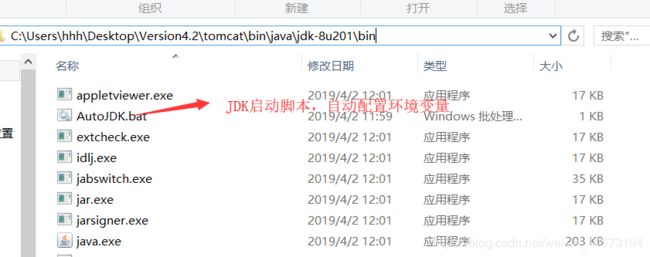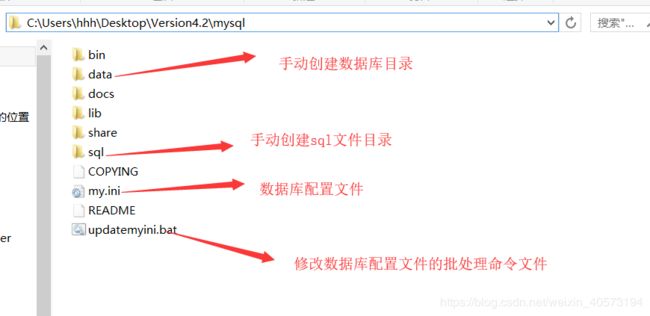JDK Tomcat MySQL一键安装
文章目录
- 材料准备
- 免安装版JDK
- 免安装版Tomcat
- 免安装版MySQL
- 微软Visual C++运行库组件
- 打包工具Inno Setup
- 统一目录
- 创建所需文件(先创建好清楚整体流程)
- 整体结构
- 文件内容
- 测试
- 打包步骤
历时两天,
材料准备
免安装版JDK
官网下载需要的JDK安装版,安装之后直接复制整个目录即可-----》JDK8官网下载链接
免安装版Tomcat
官网下载解压版解压即可-----》Tomcat8.5官网下载链接
免安装版MySQL
官网下载解压版即可-----》官网MySQL免安装版链接
微软Visual C++运行库组件
官网下载相应的版本即可-----》官网2013版链接
打包工具Inno Setup
官网下载安装即可-----》官网链接
统一目录
准备好上述材料之后,小熙建议直接在桌面新建文件夹便于操作(看个人喜好)
- 桌面新建文件夹Version4.2
- 将Tomcatcat和MySQL移动到该目录下
- 将JDK移动到Tomcat的bin目录下
- 注意:JDK、Tomcat 、MySQL的文件夹名字是可以随意改的,建议修改-----》去掉版本号等东西,便于路径的书写和防止出错。
创建所需文件(先创建好清楚整体流程)
- JDK启动脚本AutoJDK.bat-----》在JDK的bin目录下新建文本文档,修改后缀为.bat,取名随意。
- Tomcat启动脚本AutoTomcat.bat-----》在tomcat的bin目录下新建文本文档,修改后缀为.bat,取名随意。
- MySQL启动脚本AutoMySQL.bat-----》在MySQL的bin目录下新建文本文档,修改后缀为.bat,取名随意。
- MySQL修改安装路径配置脚本updatemyini.bat-----》在MySQL目录先直接新建文本文档,修改后缀为.bat,取名随意。
- MySQL配置文件my.ini-----》此文件为MySQL自带的配置文件。如果你的MySQL下没有此文件,也没有mydefault.ini文件,请直接新建文本文档,修改后缀为.ini,取名必须为my。如果有my.ini则无需创建。如果有mydefault.ini,复制一份改名为my.ini,其中mydefault.ini不需要删除。
- 打包脚本文件adk.iss-----》在根目录下(即MySQL,Tomcat同级目录)新建文本文档,修改后缀为.iss,取名随意。
- 数据库文件夹-----》在MySQL下创建data文件夹。
- SQL语句文件夹-----》在MySQL下创建sql文件夹。
- 数据库文件databasename.sql-----》导出你的数据库,以.sql结尾,放入MySQL下的sql文件夹中。
- 数据库文件建库文件-----》如果你导出的sql文件中没有建库语句(如果有小熙建议删除,然后使用本方法),请新建文本文档,修改后缀为.sql,取名随意,放入MySQL下的sql文件夹中。(看了其他的博客只用了一个sql文件,但是自动执行的时候MySQL会报错,没有选择数据库,采用此双sql文件的方法可完美解决)
- war包项目:将项目打包成war包,放在tomcat下的webapps下即可。
整体结构
请参考整体结构检查自己的结构是否正确,如果不同请调整(其实目录可以随意放,但是后续批处理脚本需要操作这些文件,涉及到路径问题,为避免麻烦和错误,请与小熙一致)
文件内容
- JDK启动脚本(其作用是自动配置环境变量)内容如下(复制到AutoJDK.bat即可):
@echo off
echo ------begin----
rem 返回上一级目录,即jdk根目录
cd ..
echo "%~dp0"
echo "%cd%"
set jdkpath=%cd%
echo %jdkpath%
rem 设置JAVA_HOME环境变量
setx JAVA_HOME "%jdkpath%" -m
rem 设置CLASSPATH环境变量
setx CLASSPATH ".;%%JAVA_HOME%%\lib\tools.jar;%%JAVA_HOME%%\lib\dt.jar" -m
echo %Path%
echo %Path%|find /i "%java_home%" && set IsNull=true || set IsNull=false
echo %IsNull%
if not %IsNull%==true (
reg add "HKEY_LOCAL_MACHINE\SYSTEM\CurrentControlSet\Control\Session Manager\Environment" /v Path /t REG_SZ /d "%Path%;%%JAVA_HOME%%\bin;%%JAVA_HOME%%\jre\bin" /f
rem 追加path变量
setx Path "%%JAVA_HOME%%\bin;%Path%"
)
exit
- tomcat启动脚本(其作用是自动将tomcat配置为服务自动启动,避免黑窗口启动方式关闭黑窗口后tomcat停止运行的问题)内容如下(复制到AutoTomcat.bat即可):
echo -------tomcat begin--------
rem 执行service.bat脚本
call "%~dp0"%service.bat install tomcat
echo -------tomcat install end------------------
sc config tomcat start= auto
net start tomcat
exit
- MySQL启动脚本(其作用是自动将配置mysql服务,自动创建数据库,创建导入数据表)内容如下(复制到AutoMySQL.bat即可):
cd ..
call updatemyini
cd bin
cd /d %~dp0
"%cd%\mysqld.exe" --initialize-insecure --user=mysql --console
echo -----mysql init succee-----
cd ..
set "MYSQL_HOME=%cd%"
cd bin
mysqld install mysql --defaults-file="%MYSQL_HOME%\my.ini"
echo -----mysql service install succee-----
net start mysql
sc config mysql start= auto
net stop mysql
net start mysql
"%cd%\mysqladmin" -u root password 123456
echo --password success
cd ..
"%cd%\bin\mysql.exe" -uroot -p123456 < "%cd%\sql\qudao1.sql"
"%cd%\bin\mysql.exe" -uroot -p123456 qudao < "%cd%\sql\qudao2.sql"
echo -----create database succee-----
echo -----mysql service command succee-----
- MySQL修改安装路径配置脚本(其作用是自动修改数据库安装路径,由于无法确定客户安装到那个目录,所以动态修改数据库的路径datadir和basedir,有的教程是在打包期间进行修改,但是会加大测试难度,小熙搞这个搞了两天,测试修改了三十多次,不可能每次都全部打包进行测试,所以建议使用小熙的方法)内容如下(复制到updatemyini.bat即可):
@echo off&setlocal ENABLEDELAYEDEXPANSION
set "basedir="%~DP0""
set "datadir="%~DP0data/""
(for /f "tokens=1* delims=:" %%a in ('FINDSTR /n .* "my.ini"') do (
for /f "delims== " %%i in ("%%b") do (
if defined %%i (echo;%%i=!%%i:\=/!)else echo;%%b
)))>$
move $ my.ini
- my.ini文件(其作用是自动配置mysql,直接使用小熙的文件即可,其中内容无需修改,除非你还想搞点别的,哈哈)内容如下(复制到my.ini即可):
# MySQL Server Instance Configuration File
# ----------------------------------------------------------------------
# Generated by the MySQL Server Instance Configuration Wizard
# Installation Instructions
# ----------------------------------------------------------------------
# On Linux you can copy this file to /etc/my.cnf to set global options,
# mysql-data-dir/my.cnf to set server-specific options
# (@localstatedir@ for this installation) or to
# ~/.my.cnf to set user-specific options.
# On Windows you should keep this file in the installation directory
# of your server (e.g. C:\Program Files\MySQL\MySQL Server X.Y). To
# make sure the server reads the config file use the startup option
# "--defaults-file".
#
# To run run the server from the command line, execute this in a
# command line shell, e.g.
# mysqld --defaults-file="C:\Users\Administrator\Desktop\mysql\my.ini"
#
# To install the server as a Windows service manually, execute this in a
# command line shell, e.g.
# mysqld --install MySQLXY --defaults-file="C:\Users\Administrator\Desktop\mysql\my.ini"
#
# And then execute this in a command line shell to start the server, e.g.
# net start MySQLXY
#
# Guildlines for editing this file
# ----------------------------------------------------------------------
#
# In this file, you can use all long options that the program supports.
# If you want to know the options a program supports, start the program
# with the "--help" option.
#
# More detailed information about the individual options can also be
# found in the manual.
#
# CLIENT SECTION
# ----------------------------------------------------------------------
#
# The following options will be read by MySQL client applications.
# Note that only client applications shipped by MySQL are guaranteed
# to read this section. If you want your own MySQL client program to
# honor these values, you need to specify it as an option during the
# MySQL client library initialization.
#
[client]
port=3306
[mysql]
default-character-set=utf8
# SERVER SECTION
# ----------------------------------------------------------------------
#
# The following options will be read by the MySQL Server. Make sure that
# you have installed the server correctly (see above) so it reads this
# file.
[mysqld]
federated
skip-external-locking
skip-name-resolve
skip-grant-tables
# The TCP/IP Port the MySQL Server will listen on
port=3306
#Path to installation directory. All paths are usually resolved relative to this.
basedir="C:\Users\Administrator\Desktop\mysql"
#Path to the database root
datadir="C:\Users\Administrator\Desktop\mysql\data"
# The default character set that will be used when a new schema or table is
# created and no character set is defined
character-set-server=utf8
# The default storage engine that will be used when create new tables when
default-storage-engine=INNODB
# Set the SQL mode to strict
sql-mode="STRICT_TRANS_TABLES,NO_AUTO_CREATE_USER,NO_ENGINE_SUBSTITUTION"
# The maximum amount of concurrent sessions the MySQL server will
# allow. One of these connections will be reserved for a user with
# SUPER privileges to allow the administrator to login even if the
# connection limit has been reached.
max_connections=100
# Query cache is used to cache SELECT results and later return them
# without actual executing the same query once again. Having the query
# cache enabled may result in significant speed improvements, if your
# have a lot of identical queries and rarely changing tables. See the
# "Qcache_lowmem_prunes" status variable to check if the current value
# is high enough for your load.
# Note: In case your tables change very often or if your queries are
# textually different every time, the query cache may result in a
# slowdown instead of a performance improvement.
query_cache_size=32M
# The number of open tables for all threads. Increasing this value
# increases the number of file descriptors that mysqld requires.
# Therefore you have to make sure to set the amount of open files
# allowed to at least 4096 in the variable "open-files-limit" in
# section [mysqld_safe]
table_open_cache=256
# Maximum size for internal (in-memory) temporary tables. If a table
# grows larger than this value, it is automatically converted to disk
# based table This limitation is for a single table. There can be many
# of them.
tmp_table_size=35M
# How many threads we should keep in a cache for reuse. When a client
# disconnects, the client's threads are put in the cache if there aren't
# more than thread_cache_size threads from before. This greatly reduces
# the amount of thread creations needed if you have a lot of new
# connections. (Normally this doesn't give a notable performance
# improvement if you have a good thread implementation.)
thread_cache_size=8
#*** MyISAM Specific options
# The maximum size of the temporary file MySQL is allowed to use while
# recreating the index (during REPAIR, ALTER TABLE or LOAD DATA INFILE.
# If the file-size would be bigger than this, the index will be created
# through the key cache (which is slower).
myisam_max_sort_file_size=100G
# If the temporary file used for fast index creation would be bigger
# than using the key cache by the amount specified here, then prefer the
# key cache method. This is mainly used to force long character keys in
# large tables to use the slower key cache method to create the index.
myisam_sort_buffer_size=69M
# Size of the Key Buffer, used to cache index blocks for MyISAM tables.
# Do not set it larger than 30% of your available memory, as some memory
# is also required by the OS to cache rows. Even if you're not using
# MyISAM tables, you should still set it to 8-64M as it will also be
# used for internal temporary disk tables.
key_buffer_size=50M
# Size of the buffer used for doing full table scans of MyISAM tables.
# Allocated per thread, if a full scan is needed.
read_buffer_size=64K
read_rnd_buffer_size=256K
# This buffer is allocated when MySQL needs to rebuild the index in
# REPAIR, OPTIMZE, ALTER table statements as well as in LOAD DATA INFILE
# into an empty table. It is allocated per thread so be careful with
# large settings.
sort_buffer_size=256K
#*** INNODB Specific options ***
# Use this option if you have a MySQL server with InnoDB support enabled
# but you do not plan to use it. This will save memory and disk space
# and speed up some things.
#skip-innodb
# Additional memory pool that is used by InnoDB to store metadata
# information. If InnoDB requires more memory for this purpose it will
# start to allocate it from the OS. As this is fast enough on most
# recent operating systems, you normally do not need to change this
# value. SHOW INNODB STATUS will display the current amount used.
#innodb_additional_mem_pool_size=14M
# If set to 1, InnoDB will flush (fsync) the transaction logs to the
# disk at each commit, which offers full ACID behavior. If you are
# willing to compromise this safety, and you are running small
# transactions, you may set this to 0 or 2 to reduce disk I/O to the
# logs. Value 0 means that the log is only written to the log file and
# the log file flushed to disk approximately once per second. Value 2
# means the log is written to the log file at each commit, but the log
# file is only flushed to disk approximately once per second.
innodb_flush_log_at_trx_commit=1
# The size of the buffer InnoDB uses for buffering log data. As soon as
# it is full, InnoDB will have to flush it to disk. As it is flushed
# once per second anyway, it does not make sense to have it very large
# (even with long transactions).
innodb_log_buffer_size=1M
# InnoDB, unlike MyISAM, uses a buffer pool to cache both indexes and
# row data. The bigger you set this the less disk I/O is needed to
# access data in tables. On a dedicated database server you may set this
# parameter up to 80% of the machine physical memory size. Do not set it
# too large, though, because competition of the physical memory may
# cause paging in the operating system. Note that on 32bit systems you
# might be limited to 2-3.5G of user level memory per process, so do not
# set it too high.
innodb_buffer_pool_size=96M
# Size of each log file in a log group. You should set the combined size
# of log files to about 25%-100% of your buffer pool size to avoid
# unneeded buffer pool flush activity on log file overwrite. However,
# note that a larger logfile size will increase the time needed for the
# recovery process.
innodb_log_file_size=20M
# Number of threads allowed inside the InnoDB kernel. The optimal value
# depends highly on the application, hardware as well as the OS
# scheduler properties. A too high value may lead to thread thrashing.
innodb_thread_concurrency=18
- 打包脚本文件(其作用是将整个项目打包成exe可执行文件,自动调用三个启动脚本)内容如下(复制到adk.iss即可):
; Script generated by the Inno Setup Script Wizard.
; SEE THE DOCUMENTATION FOR DETAILS ON CREATING INNO SETUP SCRIPT FILES!
#define MyAppName "baidu"
#define MyAppVersion "1.0"
#define MyAppPublisher "baidu"
#define MyAppURL "http://www.baidu.com/"
#define MyAppExeName ""
[Setup]
; NOTE: The value of AppId uniquely identifies this application.
; Do not use the same AppId value in installers for other applications.
; (To generate a new GUID, click Tools | Generate GUID inside the IDE.)
AppId={{FDFD0778-244E-4D04-A78A-F54F3D5D675E}
AppName={#MyAppName}
AppVersion={#MyAppVersion}
AppVerName={#MyAppName} {#MyAppVersion}
AppPublisher={#MyAppPublisher}
AppPublisherURL={#MyAppURL}
AppSupportURL={#MyAppURL}
AppUpdatesURL={#MyAppURL}
DefaultDirName={pf}\{#MyAppName}
DisableProgramGroupPage=yes
OutputBaseFilename=BaiDu
Compression=lzma
SolidCompression=yes
[Languages]
Name: "english"; MessagesFile: "compiler:Default.isl"
[Tasks]
Name: "desktopicon"; Description: "{cm:CreateDesktopIcon}"; GroupDescription: "{cm:AdditionalIcons}"; Flags: unchecked
[Files]
;拷贝tomcat
Source:"C:\Users\hhh\Desktop\Version3.2\tomcat\*";DestDir:"{app}\tomcat";Flags:igNoreversion recursesubdirs createallsubdirs
;拷贝mysql
Source:"C:\Users\hhh\Desktop\Version3.2\mysql\*";DestDir:"{app}\mysql";Flags:igNoreversion recursesubdirs createallsubdirs
[Icons]
Name: "{commonprograms}\{#MyAppName}"; Filename: "{app}\{#MyAppExeName}"
Name: "{commondesktop}\{#MyAppName}"; Filename: http://localhost:80/adkfp;
[Run]
;执行三个bat文件
Filename: "{app}\tomcat\bin\java\jdk-8u201\bin\AutoJDK.bat";
Filename: "{app}\tomcat\bin\AutoTomcat.bat";
Filename: "{app}\mysql\bin\AutoMySQL.bat";
注释:
OutputBaseFilename=baidu-----》你的exe可执行文件的名字
7. 数据库建库sql文件(其作用是创建数据库,就一行sql语句)内容如下(复制到adk.iss即可):
CREATE DATABASE yourdatabasename;
测试
小熙建议每个模块单独测试之后再进行打包操作,不然各种错误足够折腾了,一步一步稳步前行才是真的。测试环境最好是纯净版本的Windows系统,没有安装过以上三大软件的,如果有请清理掉,建议在虚拟机进行(小熙刚好有一台快到期的云服务器,哈哈,测试一遍重装一遍系统,反正云服务器一键搞定)
-
测试JDK
- 将tomcat目录复制到的环境中(桌面即可)
- 进入AutoJDK.bat的目录双击启动
- 黑窗口一闪而过(如果娘=你想看看发生了什么,请在AutoJDK.bat末尾添加pause暂停命令)
- Windows+R-----》 cmd -----》java -version 这个大家都会吧。。。。查看一下是否安装好
- JDK是基本不会出问题的,tomcat和mysql涉及服务的问题会多一些。
- 如果测试成功了,就进行下一步Tomcat了。
-
测试Tomcat
- 进入AutoTomcat.bat的目录双击启动
- 黑窗口依旧一闪而过(如果加了pause暂停,打包前一定要去掉,尽量减少客户操作嘛,把客户当成。。。。你懂)
- 打开浏览器输入localhost:8080即可,添加了项目也可以测试项目呀,随你,端口冲突什么的不用教怎么改了吧。。。。





